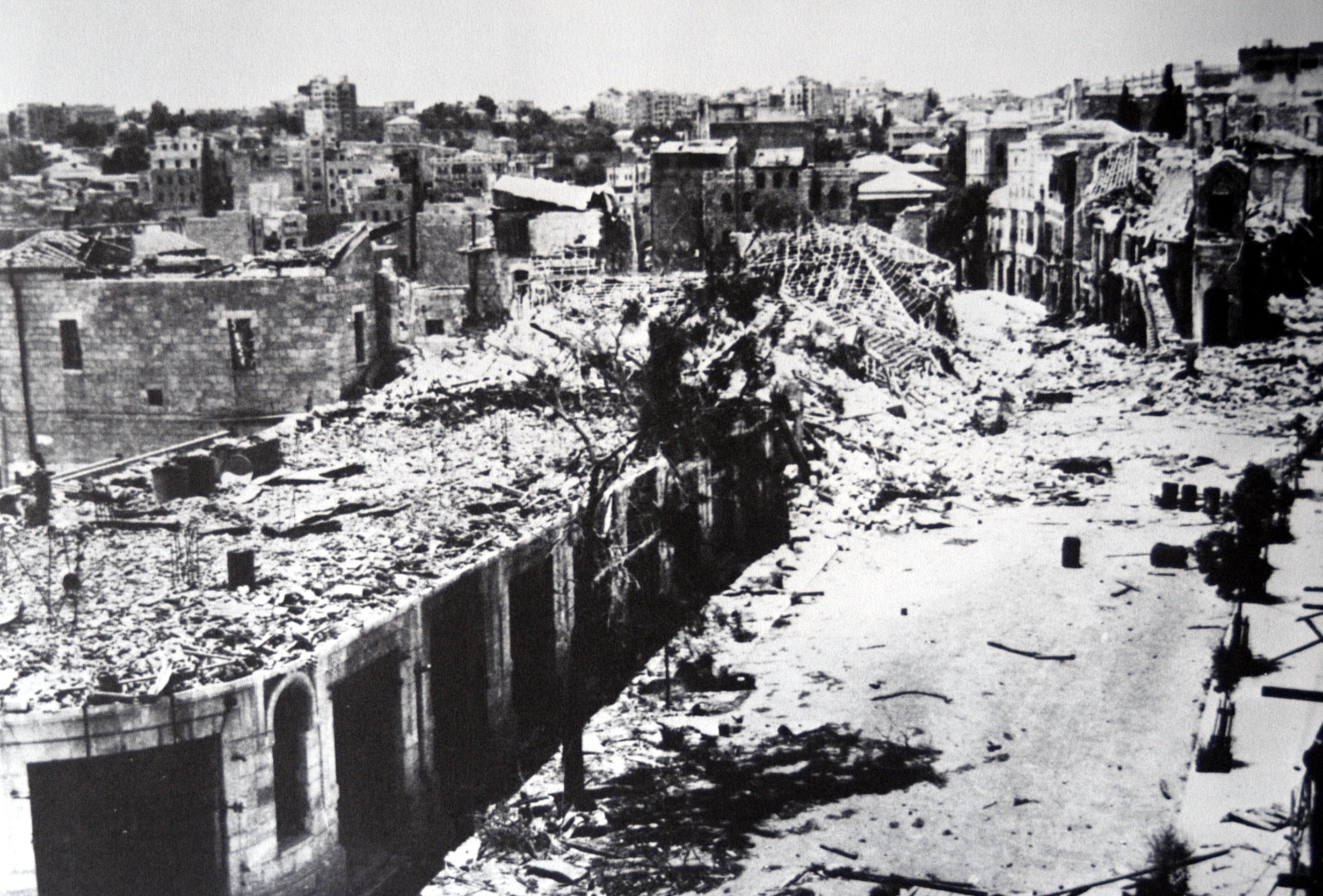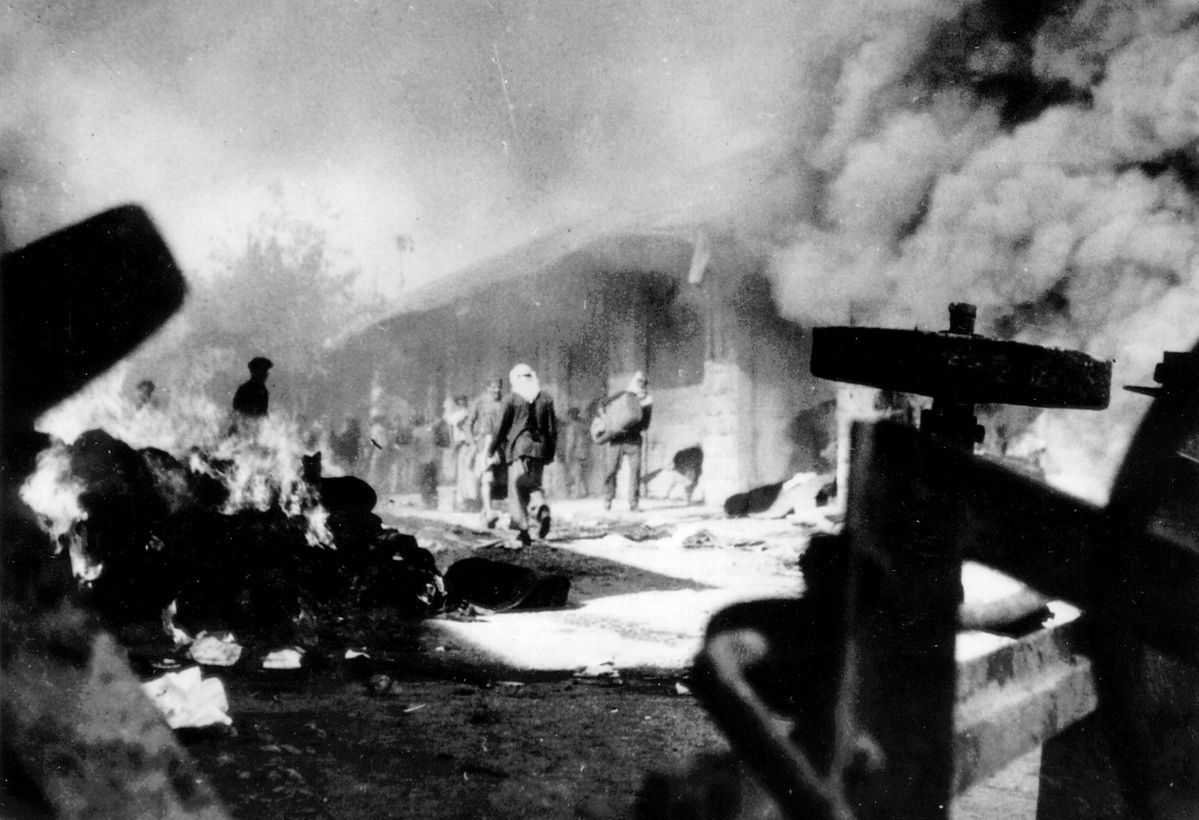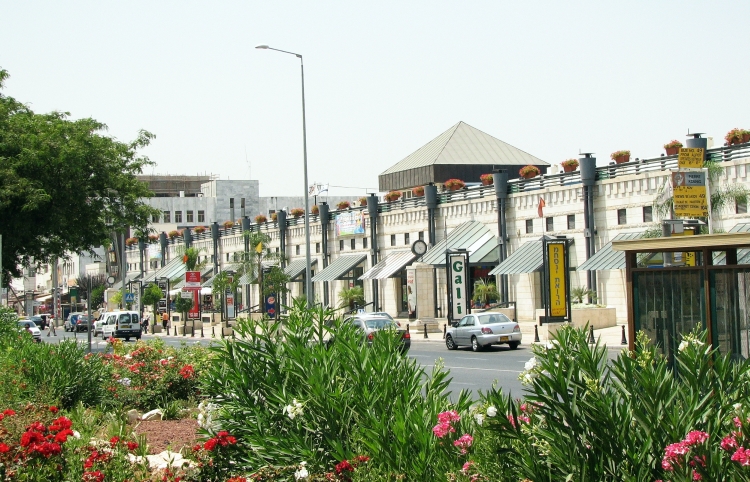|
Mamilla Mall
Mamilla Mall, also called Alrov Mamilla Avenue, is an upscale shopping street and the only open-air mall in West Jerusalem. Located northwest of Jaffa Gate, the mall consists of a pedestrian promenade called Alrov Mamilla Avenue lined by 140 stores, restaurants, and cafes, and office space on upper floors. It sits atop a multi-story parking garage for 1,600 cars and buses, and a bus terminal. Designed by Moshe Safdie and developed by Alrov Properties and Lodgings Ltd. of Tel Aviv, the mall incorporates the facades of 19th-century buildings from the original Mamilla Street, as well as the original structures of the Convent of St. Vincent de Paul, the Stern House, and the Clark House. The mall is part of the Alrov Mamilla Quarter, a $400 million mixed-use development that also includes the David's Village luxury condominium project, the David Citadel Hotel, the Alrov Mamilla Hotel, and the Karta parking lot. While the overall project was approved by the municipality in the ear ... [...More Info...] [...Related Items...] OR: [Wikipedia] [Google] [Baidu] |
Walls Of Jerusalem
The Walls of Jerusalem ( he, חומות ירושלים, ar, أسوار القدس) surround the Old City of Jerusalem (approx. 1 km2). In 1535, when Jerusalem was part of the Ottoman Empire, Sultan Suleiman I ordered the ruined city walls to be rebuilt. The work took some four years, between 1537 and 1541. The walls are visible on most old maps of Jerusalem over the last 1,500 years. The length of the walls is 4,018 meters (2.4966 mi), their average height is 12 meters (39.37 feet) and the average thickness is 2.5 meters (8.2 feet). The walls contain 34 watchtowers and seven main gates open for traffic, with two minor gates reopened by archaeologists. In 1981, the Jerusalem walls were added, along with the Old City of Jerusalem, to the UNESCO World Heritage Site List. Pre-Israelite city The city of Jerusalem has been surrounded by walls for its defense since ancient times. In the Middle Bronze Age, a period also known in biblical terms as the era ... [...More Info...] [...Related Items...] OR: [Wikipedia] [Google] [Baidu] |
1947 Jerusalem Riots
The 1947 Jerusalem Riots occurred following the vote in the UN General Assembly in favour of the 1947 UN Partition Plan on 29 November 1947. The Arab Higher Committee declared a three-day strike and public protest to begin on 2 December 1947, in protest at the vote. Arabs marching to Zion Square on December 2 were stopped by the British, and the Arabs instead turned towards the commercial center of the City at Mamilla and Jaffa Road, burning many buildings and shops. Violence continued for two more days, with a number of Jewish neighborhoods being attacked. The New York Times, December 3, 1947, has a three column headline on the front page: "JERUSALEM TORN BY RIOTING; ARABS USE KNIVES, SET FIRES; JEWS REPLY, HAGANAH IN OPEN" with subheads that include: "14 Are Slain In Day" "8 Jews Reported Killed in Palestine Clashes--Mob Loots Shops" etc. A consequence of the violence was the decision by the Haganah Jewish paramilitary organization to use force to "stop future attacks on Jews ... [...More Info...] [...Related Items...] OR: [Wikipedia] [Google] [Baidu] |
Ladbrokes
Ladbrokes Coral is a British gambling company founded in 1886. Its product offering includes sports betting, online casino, online poker, and online bingo. The business is split into two divisions, UK and International. UK operations are conducted from its headquarters in London, England, while its International business operates from its overseas hubs in Gibraltar and Ceuta, Spain. The Ladbrokes portion of the group was established in 1886, and Coral in 1926. In November 2016, the companies merged to create Ladbrokes Coral Group. Since March 2018, it has been owned by Entain (formerly GVC Holdings). Prior to its sale, Ladbrokes Coral was listed on the London Stock Exchange, and was a member of the FTSE 250 Index. History The company was founded by Messrs. Schwind and Pennington in 1886, as commission agents for horses trained at Ladbroke Hall in Warwickshire. The name Ladbrokes was adopted in 1902, when Arthur Bendir joined the partnership, and operations were moved to Lo ... [...More Info...] [...Related Items...] OR: [Wikipedia] [Google] [Baidu] |
Talpiot
Talpiot ( he, תלפיות, literally 'turrets' or 'magnificently built') is an Israeli neighborhood in southeastern Jerusalem, established in 1922 by Zionist pioneers. It was built as a garden suburb on land purchased by the Tel Aviv-based Palestine Land Development Company and other Jewish building societies. Talpiot has become a major commercial center and a hub of nonprofit organizations. The Talpiot industrial zone is one of the largest in the country, with plans for expansion as a center of shopping, entertainment and industry. Etymology The name ''Talpiot'' derives from a verse in Song of Songs 4:4: "Thy neck is like the tower of David, built with turrets". According to rabbinic sources, Talpiot refers to the Temple. It was said to be a compound of the Hebrew words (hill) and (mouths), as in "the hill to which all mouths turn in prayer". History In the 1920s, the Bauhaus architect Richard Kauffmann presented the British Mandate authorities with a plan for Talpiot, w ... [...More Info...] [...Related Items...] OR: [Wikipedia] [Google] [Baidu] |
Arutz Sheva
''Arutz Sheva'' ( he, ערוץ 7, lit=''Channel 7''), also known in English as ''Israel National News'', is an Israeli media network identifying with religious Zionism. It offers online news articles in Hebrew, English, and Russian as well as live streaming radio, video and free podcasts. It also publishes a weekly newspaper, ''B'Sheva'', with the third-largest weekend circulation in the country. History In the 1970s an offshore radio station Voice of Peace was launched, broadcasting pacifistic messages. In response, Rabbi Zalman Baruch Melamed launched radio station ''Arutz Sheva'' in 1988, aimed at Israelis opposed to negotiations with the Palestine Liberation Organization. Based in Beit El, the station generated its broadcast on the Israeli airwaves from the ship MV ''Eretz HaTzvi'' in the Mediterranean Sea. It was one of the first Internet radio stations and was used as a beta tester for RealPlayer. From 1996 to 2002, ''Arutz Sheva'' broadcast in Russian. In 2003, ''Arutz S ... [...More Info...] [...Related Items...] OR: [Wikipedia] [Google] [Baidu] |
Baka, Jerusalem
Baka ( ar, بقعه, lit. "Valley"; he, בַּקְעָה) is a neighborhood in southern Jerusalem. The official name is Geulim, which is mainly used on road signs. Geography The neighborhood is somewhat trapezoidal, sandwiched between Derech Hevron on the east at 760 meters above sea level and sloping downward toward Derech HaRakevet and General Pierre Koenig Street on the western side at 740 meters. The old Jerusalem Railway Station occupies the north-eastern point with Rivka Street forming the southern base. Baka is bounded by Abu Tor to the northeast, Talpiot to the east, Talpiot Industrial Zone to the south, Mekor Chaim to the west, and the Greek Colony and German Colony to the northwest. The north-south Derech Beit Lehem serves as the major commercial artery within the neighborhood. History Baka was established in the late 19th century after the completion of the Jerusalem Railway Station. The station created the nucleus of a commercial center that eventually attrac ... [...More Info...] [...Related Items...] OR: [Wikipedia] [Google] [Baidu] |
Katamon
, settlement_type = Neighborhood of Jerusalem , image_skyline = בית רה"מ לוי אשכול ברחוב בוסתנאי 3 בשכנות קטמון בירושלים.jpg , imagesize = 300px , image_caption = House of Levi Eshkol , subdivision_type = Country , subdivision_name = , subdivision_type1 = District , subdivision_name1 = Jerusalem District , subdivision_type2 = City , subdivision_name2 = Jerusalem , population_footnotes = , population_as_of = 2017 , population_total = 5,980 , area_code_type = Area code Katamon or Qatamon ( ar, قطمون ''Katamun'', he, קטמון, el, Καταμώνας ''Katamónas'') is a neighborhood in south-central Jerusalem. The official Hebrew name, Gonen (), is mainly used in municipal publications. Katamon is derived from the Greek κατὰ τῷ μοναστηρίῳ ("by the monastery"). The neighborhood is built next to an old Greek Orthodox monastery, believe ... [...More Info...] [...Related Items...] OR: [Wikipedia] [Google] [Baidu] |
Pisgat Ze'ev
Pisgat Ze'ev ( he, פסגת זאב, lit. ''Ze'ev's Peak'') is an Israeli settlement in East Jerusalem and the largest residential neighborhood in Jerusalem with a population of over 50,000. Pisgat Ze'ev was established by Israel as one of the city's five Ring Neighborhoods on land effectively annexed after the 1967 Six-Day War. The international community considers Israeli settlements in East Jerusalem illegal under international law, but the Israeli government disputes this. Pisgat Ze'ev is situated east of Shuafat and Beit Hanina, west of Hizma, south of Neve Yaakov, and north of 'Anata and the Shuafat refugee camp. The Israeli West Bank barrier includes Pisgat Ze'ev in the northern section of Jerusalem while excluding Shuafat refugee camp from the city by running in an S-shape here. History Antiquity Archeological evidence shows that in the biblical period, the site encompassed small agricultural villages along routes north from Jerusalem to Nablus and the Galilee. The ... [...More Info...] [...Related Items...] OR: [Wikipedia] [Google] [Baidu] |
Neve Yaakov
Neve Yaakov also Neve Ya'aqov, ( he, נווה יעקב; lit. Jacob's Oasis), is an Israeli settlement and neighborhood located in East Jerusalem East Jerusalem (, ; , ) is the sector of Jerusalem that was held by Jordan during the 1948 Arab–Israeli War, as opposed to the western sector of the city, West Jerusalem, which was held by Israel. Jerusalem was envisaged as a separat ..., north of Pisgat Ze'ev and south of al-Ram. Established in 1924 during the period of the Mandatory Palestine, British Mandate, it was depopulated during the 1948 Arab–Israeli War. The area was captured by Israel in the Six-Day War and a new neighborhood was built nearby, at which time international opposition to its legitimacy began. The international community considers Israeli settlements in East Jerusalem International law and Israeli settlements, illegal under international law, but the Israeli government disputes this, defining it as a neighborhood within the jurisdiction of the J ... [...More Info...] [...Related Items...] OR: [Wikipedia] [Google] [Baidu] |
Old City (Jerusalem)
The Old City of Jerusalem ( he, הָעִיר הָעַתִּיקָה, translit=ha-ir ha-atiqah; ar, البلدة القديمة, translit=al-Balda al-Qadimah; ) is a walled area in East Jerusalem. The Old City is traditionally divided into four uneven quarters, namely: the Muslim Quarter, the Christian Quarter, the Armenian Quarter, and the Jewish Quarter. A fifth area, the Temple Mount, known to Muslims as the ''Haram al-Sharif'', is home to the Dome of the Rock, Al-Aqsa Mosque and was once the site of two Jewish Temples. The current designations were introduced in the 19th century. The Old City's current walls and city gates were built by the Ottoman Empire from 1535 to 1542 under Suleiman the Magnificent. The Old City is home to several sites of key importance and holiness to the three major Abrahamic religions: the Temple Mount and Western Wall for Judaism, the Church of the Holy Sepulchre for Christianity, and the Dome of the Rock and al-Aqsa Mosque for Islam. The ... [...More Info...] [...Related Items...] OR: [Wikipedia] [Google] [Baidu] |
Teddy Kollek
Theodor "Teddy" Kollek ( he, טדי קולק; 27 May 1911 – 2 January 2007) was an Israeli politician who served as the mayor of Jerusalem from 1965 to 1993, and founder of the Jerusalem Foundation. Kollek was re-elected five times, in 1969, 1973, 1978, 1983, and 1989. After reluctantly running for a seventh term in 1993 at the age of 82, he lost to Likud candidate and future Prime Minister of Israel Ehud Olmert. During his tenure, Jerusalem developed into a modern city, especially after its reunification in 1967. He was once called "the greatest builder of Jerusalem since Herod." Early life and marriage Theodor (Teddy) Kollek was born in Nagy-Vázsony, 120 km from Budapest, Hungary as Kollek Tivadar. His parents, Alfred and Margaret, née Fleischer, named him after Theodor Herzl. The family moved to Vienna in 1918. Growing up in the Austrian capital city, Kollek came to share his father Alfréd's Zionist convictions. In 1935, three years before the Nazis seized p ... [...More Info...] [...Related Items...] OR: [Wikipedia] [Google] [Baidu] |

.jpg)



.jpg)




